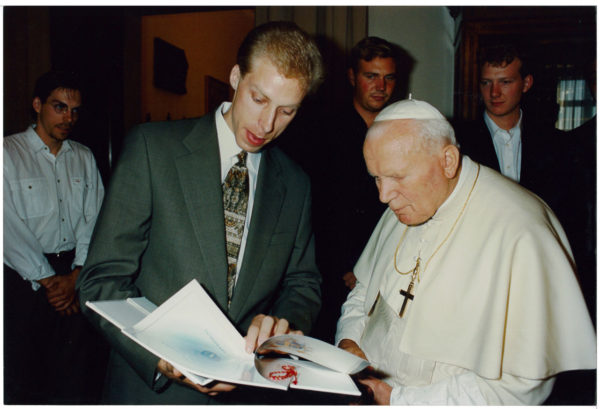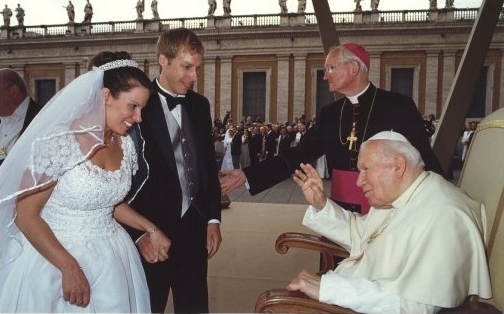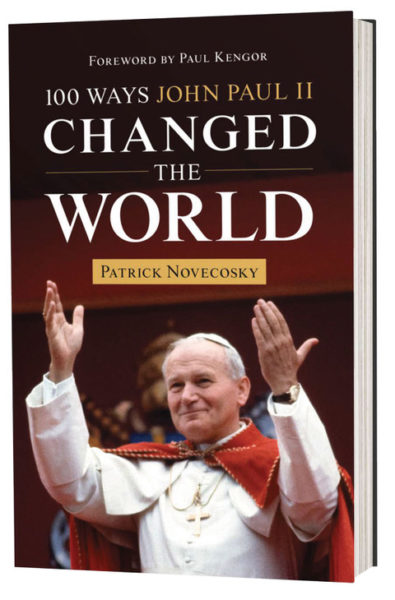Everyone expected me to be nervous. Everyone except my mother, of course. I even expected a case of the jitters. After all, you don’t come face-to-face with a living saint every day.
I was 29 years old when I met John Paul II for the first time — 25 years ago today. How I came to stand before St. Peter’s successor is just one of God’s many little miracles in my life.
This particular miracle originated with a simple raffle ticket I bought in the fall of 1996, just a few months into my tenure with the Marians of the Immaculate Conception in Stockbridge, Massachusetts. The Marians would ask their vendors to provide prizes for the drawing every year. Employees would buy tickets, and the proceeds would go to charity. That year, the grand prize was a trip for two to Cancun.
When Richard Cervera, then the Marians’ CFO, pulled my name for the grand prize ticket, I knew God was up to something. I was a young journalist then, associate editor of Marian Helper magazine, and I had no desire to sit on a beach in Mexico. However, I had always dreamed of Rome. A month later, I called the travel agency that had donated the prize and asked if I could swap out the ticket. They agreed, and my employer arranged for me to stay at their monastery in Rome with an ambitious agenda beyond the Eternal City.
After the fall of the Soviet Union, Pope John Paul II asked the Marians to lead the re-evangelization of Eastern Europe. Dozens of Marian priests had lived behind the Iron Curtain during communist rule. In the fall of 1997, I traveled to these countries and interviewed these men. I told their stories in Marian Helper.
Going to Rome
The Marians knew John Paul well. Their superior general had known the Polish pontiff since their teaching days together at the Catholic University of Lublin. Marian priests and brothers regularly visited the Pope, so when they found out I would be in Rome, my boss asked if I wanted to stay at the Marians’ house in Rome and meet the pope.
“Yes, please,” I replied.
John Paul typically celebrated Mass in his private chapel every morning. Bishops visiting Rome were welcomed to concelebrate the Mass with him. If any of the thirty-five seats in the tiny chapel were open, and a lay person was fortunate enough to be on the list kept by his long-time private secretary, Monsignor Stanisław Dziwisz (now Cardinal Emeritus of Krakow, Poland), the Pope’s office would call the evening before.
My call came on the second last day of my visit to Rome. I had been asking for the intercession of Saint Thérèse of Lisieux because she met Pope Leo XIII when she visited Rome in 1887. My prayers were answered in spectacular fashion.
My brother, Fred, accompanied me to Rome and beyond. Each evening after returning to the monastery, we’d ask the little Italian nun who answered the phones, “Was there a call from the Vatican?”
“No, signori. No call,” she’d reply.
On our fourth afternoon in Rome, we wandered into the Archbasilica of Saint John Lateran, the cathedral for the Diocese of Rome. Television cameras were set up inside the church, and posters of Thérèse were everywhere, with writing in Italian that I couldn’t make sense of at the time. It reminded me to ask her intercession once again for the grace to meet the Holy Father.
I whispered a little prayer, and then we returned to the monastery on Via Corsica.
This time, the little nun came looking for us.
“Signori,” she said, looking at both of us. “They called. You will see the Holy Father tomorrow.”
“Both of us?” Fred asked. “I didn’t bring a suit!”
“They asked how many. I said two!”
And there it was. Fred had slacks and a dress shirt. That would have to do!
Not only would we meet John Paul II on the Little Flower’s feast day, October 1, 1997, but months later, I discovered that the day the prayer was answered — September 30, 1997—was exactly 100 years to the day that Thérèse Martin was called home to the Lord! Ergo, the posters at Saint John Lateran.
I suspect the Lord grants the Little Flower more than one extraordinary miracle every century. Nonetheless, this miracle didn’t go unnoticed.
The Audience
We got up early on our special day, and I called my parents. Six o’clock in the morning Rome time was 10 p.m. in Saskatchewan. They were watching the National News on CBC.
“We’re meeting the pope this morning,” I told them. Based on their reaction, they may have been even more excited than we were.
When Fred and I arrived at the Portone di Bronzo, the main entrance to the Apostolic Palace under the colonnade in St. Peter’s Square, I was nervous. I’d been to my share of important events before, but being invited to Mass in the Pope’s private chapel was a big deal — especially for a couple of farm boys from Saskatchewan!
A Swiss Guard led us up some stairs, through a courtyard, and up more stairs until we reached the top floor of the Apostolic Palace. Monsignor Dziwisz greeted us. He instructed us to leave our backpacks behind before leading us to the chapel.

Patrick’s first audience with Pope John Paul II in the Papal Apartments on Oct. 1, 1997.
As I rounded the corner into the chapel, my heart skipped a beat. Literally. I must have gasped, too. A mere 30 feet in front of me was the Vicar of Christ, and he glowed! John Paul was kneeling before the Tabernacle, deep in prayer. The moment lasted a couple of seconds, but for me, time stood still. It was entirely surreal, and any anxiety I carried with me instantly evaporated.
The chapel seated maybe thirty-five people, including the eight priests concelebrating with the pope that day. The image of Our Lady of Częstochowa at the foot of the cross, the stained-glass panel on the walls and ceiling, and the bird of paradise flowers beside the altar were permanently etched in my mind that day.
The Novus Ordo Mass in Latin was short with no homily. The altar was against the wall, so the Holy Father faced the tabernacle while celebrating Mass. I noticed that he struggled a little to rise after his genuflections. He didn’t distribute Communion himself. It was nonetheless an extraordinary honor to receive the Blessed Sacrament consecrated at the hands of this holy man.
After Mass, we were led to the adjoining room, where we formed a horseshoe-shaped reception line for the Holy Father. I was the only one in the group with a gift for him that day. As I waited, the anxiety returned. What would I say to him? When he entered the room, however, I was filled with peace. Talking to him was like standing next to my own father, explaining what I did at work that day. Monsignor Dziwisz introduced me as being from “Padri Mariani,” Italian for “Marian Fathers.”
I presented John Paul II with pages from marian.org, bound in a hand-tooled white leather folder with gold embossing. I had recently become the webmaster, and we had newly published pages on the pope’s work advancing the cause of Sister Faustina Kowalska and the Divine Mercy message.
He thanked me and pressed a rosary in my hand. Monsignor Dziwisz took my gift, and the Holy Father moved to the next person in line.
Fred and I celebrated our blessed day with a lunchtime feast! It was a remarkable day that changed our lives.
After my 1997 audience, I had annual encounters with John Paul for five years. In 1998, I shook hands with him in Saint Peter’s Square. A week later, I had another private audience and presented him with a gift on the 50th anniversary of his episcopal ordination.

The Novecosky newlyweds are presented to Pope John Paul II in April 2002
During the Pope’s 1999 visit to the Basilica of Our Lady of Licheń in Poland, I stayed onsite with him and a sizable delegation of Marians from around the world. It was a rare treat to see the pope in his element. I was one of the few laypeople in the small group that greeted him upon his arrival. He bantered back and forth with the Marians in Polish, tossing out the occasional joke that had the men in stitches.
In 2000, I was in Rome for Sister Faustina’s canonization. I again had the opportunity to present the Holy Father with pages from the newly updated marian.org website.
Then, in 2002, just 11 days after I wed my bride, we were presented to John Paul II during his Wednesday audience in the Square as the first of the “sposi novelli” (newlyweds) that day. It was the last of my five encounters with this great saint, largely thanks to the intercession of a French nun who called in a favor for this Canadian farm boy.
Merci, Thérèse!
Patrick Novecosky is a Virginia-based journalist, author, international speaker, and pro-life activist. He met Pope St. John Paul II five times. His new book is 100 Ways John Paul II Changed the World.


